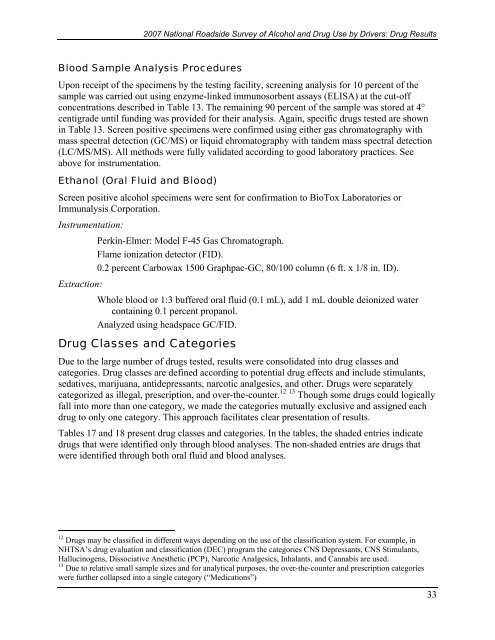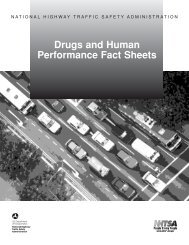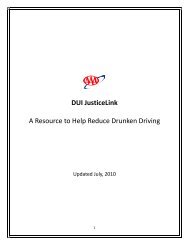2007 National Roadside Survey of Alcohol and Drug Use by Drivers
2007 National Roadside Survey of Alcohol and Drug Use by Drivers
2007 National Roadside Survey of Alcohol and Drug Use by Drivers
Create successful ePaper yourself
Turn your PDF publications into a flip-book with our unique Google optimized e-Paper software.
<strong>2007</strong> <strong>National</strong> <strong>Roadside</strong> <strong>Survey</strong> <strong>of</strong> <strong>Alcohol</strong> <strong>and</strong> <strong>Drug</strong> <strong>Use</strong> <strong>by</strong> <strong>Drivers</strong>: <strong>Drug</strong> ResultsBlood Sample Analysis ProceduresUpon receipt <strong>of</strong> the specimens <strong>by</strong> the testing facility, screening analysis for 10 percent <strong>of</strong> thesample was carried out using enzyme-linked immunosorbent assays (ELISA) at the cut-<strong>of</strong>fconcentrations described in Table 13. The remaining 90 percent <strong>of</strong> the sample was stored at 4°centigrade until funding was provided for their analysis. Again, specific drugs tested are shownin Table 13. Screen positive specimens were confirmed using either gas chromatography withmass spectral detection (GC/MS) or liquid chromatography with t<strong>and</strong>em mass spectral detection(LC/MS/MS). All methods were fully validated according to good laboratory practices. Seeabove for instrumentation.Ethanol (Oral Fluid <strong>and</strong> Blood)Screen positive alcohol specimens were sent for confirmation to BioTox Laboratories orImmunalysis Corporation.Instrumentation:Perkin-Elmer: Model F-45 Gas Chromatograph.Flame ionization detector (FID).0.2 percent Carbowax 1500 Graphpac-GC, 80/100 column (6 ft. x 1/8 in. ID).Extraction:Whole blood or 1:3 buffered oral fluid (0.1 mL), add 1 mL double deionized watercontaining 0.1 percent propanol.Analyzed using headspace GC/FID.<strong>Drug</strong> Classes <strong>and</strong> CategoriesDue to the large number <strong>of</strong> drugs tested, results were consolidated into drug classes <strong>and</strong>categories. <strong>Drug</strong> classes are defined according to potential drug effects <strong>and</strong> include stimulants,sedatives, marijuana, antidepressants, narcotic analgesics, <strong>and</strong> other. <strong>Drug</strong>s were separatelycategorized as illegal, prescription, <strong>and</strong> over-the-counter. 12 13 Though some drugs could logicallyfall into more than one category, we made the categories mutually exclusive <strong>and</strong> assigned eachdrug to only one category. This approach facilitates clear presentation <strong>of</strong> results.Tables 17 <strong>and</strong> 18 present drug classes <strong>and</strong> categories. In the tables, the shaded entries indicatedrugs that were identified only through blood analyses. The non-shaded entries are drugs thatwere identified through both oral fluid <strong>and</strong> blood analyses.12 <strong>Drug</strong>s may be classified in different ways depending on the use <strong>of</strong> the classification system. For example, inNHTSA’s drug evaluation <strong>and</strong> classification (DEC) program the categories CNS Depressants, CNS Stimulants,Hallucinogens, Dissociative Anesthetic (PCP), Narcotic Analgesics, Inhalants, <strong>and</strong> Cannabis are used.13 Due to relative small sample sizes <strong>and</strong> for analytical purposes, the over-the-counter <strong>and</strong> prescription categorieswere further collapsed into a single category (“Medications”)33




